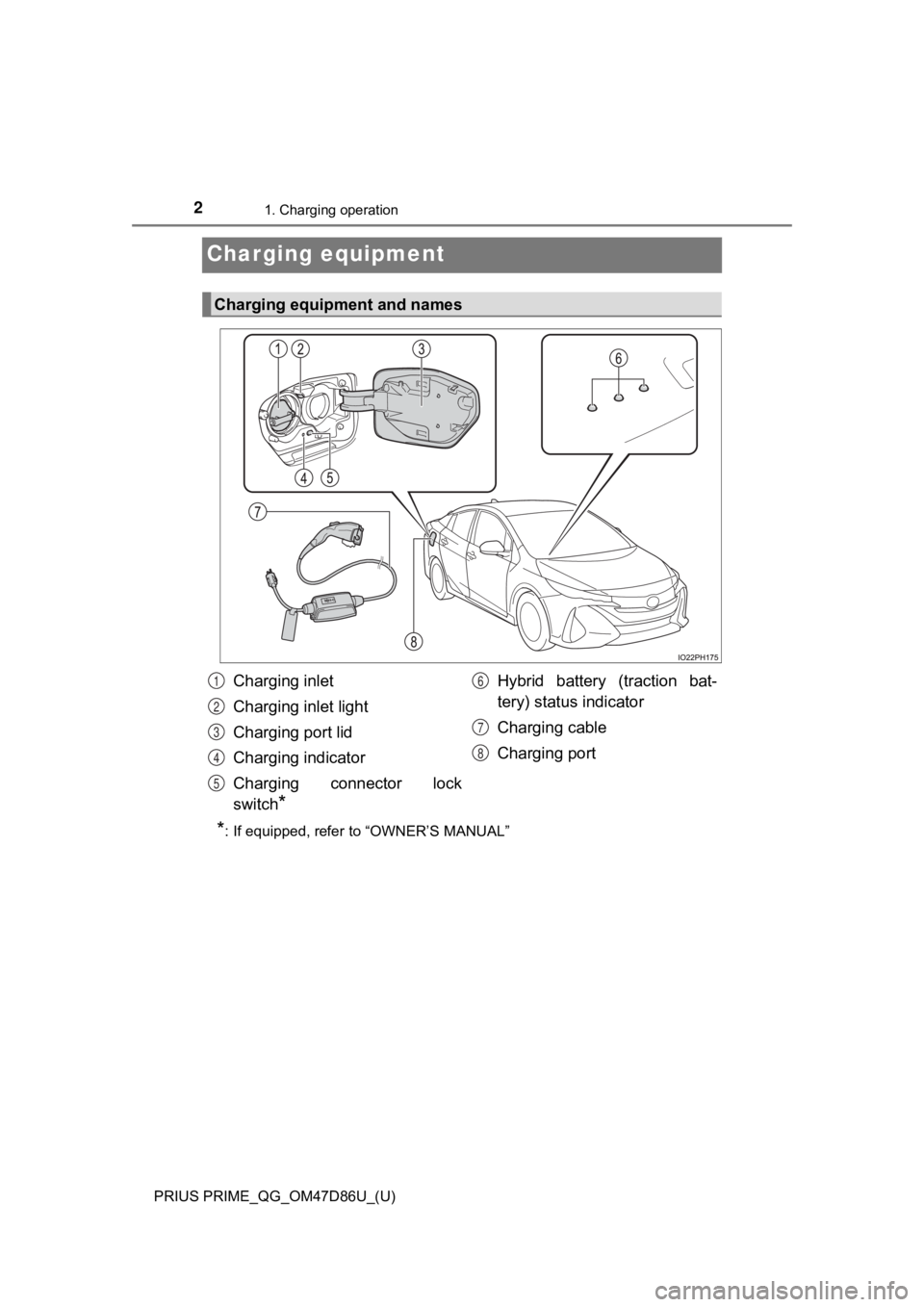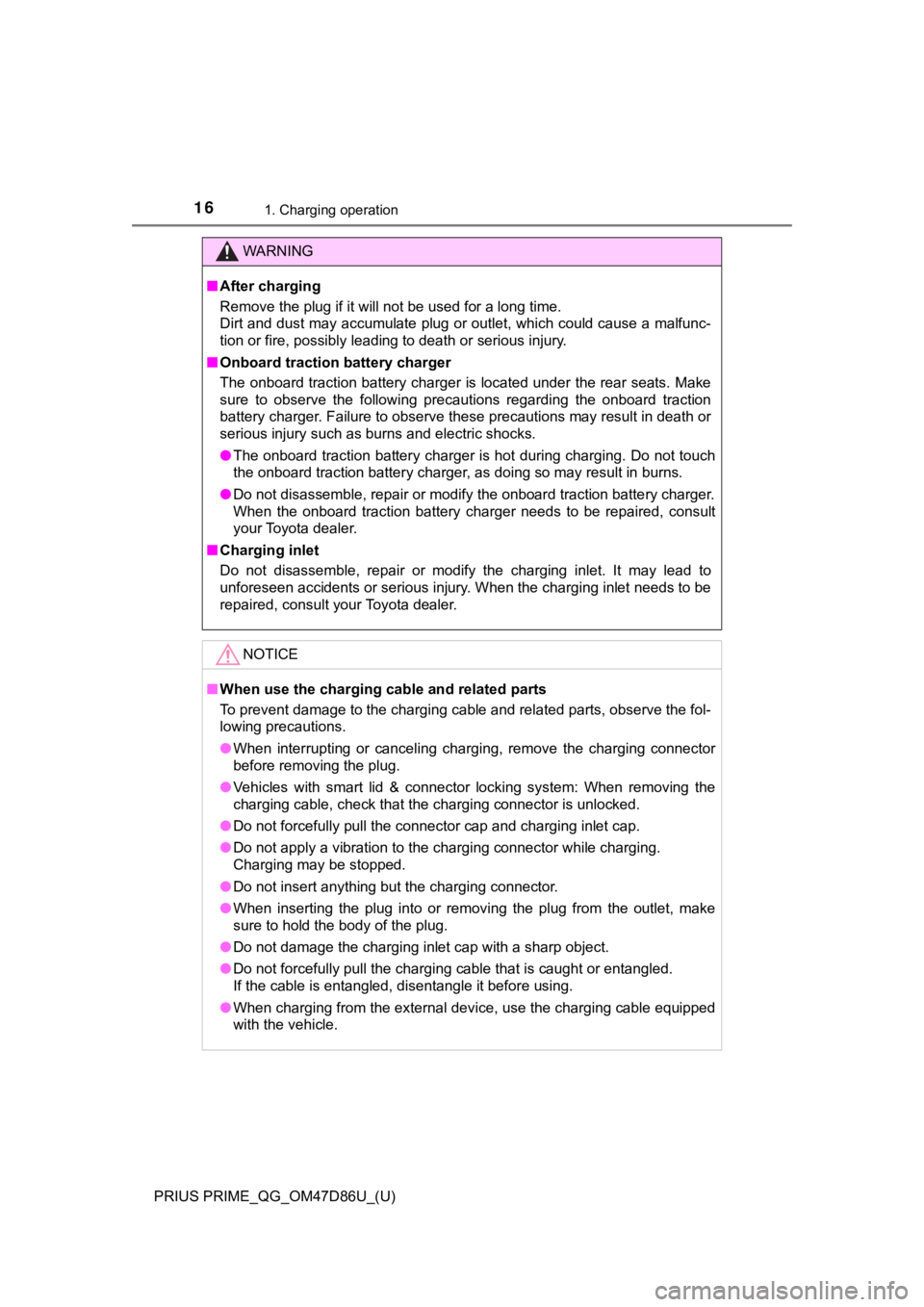2021 TOYOTA PRIUS PRIME battery
[x] Cancel search: batteryPage 2 of 40

2
PRIUS PRIME_QG_OM47D86U_(U)
1. Charging operation
Charging equipment
*: If equipped, refer to “OWNER’S MANUAL”
Charging equipment and names
Charging inlet
Charging inlet light
Charging port lid
Charging indicator
Charging connector lock
switch
*
Hybrid battery (traction bat-
tery) status indicator
Charging cable
Charging port1
2
3
4
5
6
7
8
Page 8 of 40

8
PRIUS PRIME_QG_OM47D86U_(U)
1. Charging operation
When the charging cable is con-
nected to the charging inlet, the
user is informed of the charging
status of the hybrid battery (trac-
tion battery) by the statuses of 3
indicators (turned off, illuminated
or flashing).
■When the hybrid battery (tract ion battery) is fully charged
When the charging cable is connected, all 3 hybrid battery (tra ction battery)
status indicators illuminate to inform the user that the hybrid battery (traction
battery) is fully charged.
The illumination/flashing pattern
changes to inform the user of the
charging status.
Hybrid battery (traction battery) status indicator
Charging indicator
Page 10 of 40

10
PRIUS PRIME_QG_OM47D86U_(U)
1. Charging operation
Before charging, always check the following items.
● The parking brake is applied.
● The headlights are switched off or set to AUTO, and lights such as
the emergency flashers and interi or lights etc. are switched off.
If these light switches are turned ON, then these features will consume
electricity, and charging time will increase.
●The power switch is off.
The time required to charge the hybrid battery (traction battery) differs
according to the charging vol tage and charging current.
*1: This is the maximum value.
*2: The time required for charging to complete depends on conditions such as
the remaining charge of the hybrid battery (traction battery), the outside
temperature and specifications of a charger (charging station).
Confirm the following before charging
Estimated charging time
Connected power sourceCharging stationHome power source
Charging voltageAC 240 VAC 120 V
Charging current*116A12A
Estimated charging
time
*2Approximately 2 hoursApproximately 5 hours 10 minutes
Page 13 of 40

PRIUS PRIME_QG_OM47D86U_(U)
131. Charging operation
1
Charging operation
Vehicles with smart lid & con-
nector locking system:
When you wish to lock the
charging connector, carry an
electronic key and press the
charging connector lock switch.
The charging connector will be
locked by the smart lid & connector
locking system. After the charging
connector is locked, the charging
connector cannot be unlocked by
pressing the charging connector
lock switch if the electronic key is
not in detection area of charging
port lid.
The charging indicator will turn off when charging is completed .
■During charging
●The surface of the CCID (Charging Circuit Interrupting Device) may become
hot, but this does not indicate a malfunction.
● Depending on radio wave conditions, interference may be heard o n the
radio.
● The current charging condition and the estimated time until cha rging will
complete can be checked on the multi-information display or 11. 6-inch dis-
play (if equipped).
● During charging, the hybrid battery (traction battery) status i ndicator illumi-
nates and flashes, and changes according to the charging amount .
8
Page 16 of 40

16
PRIUS PRIME_QG_OM47D86U_(U)
1. Charging operation
WARNING
■After charging
Remove the plug if it will not be used for a long time.
Dirt and dust may accumulate plug or outlet, which could cause a malfunc-
tion or fire, possibly leading to death or serious injury.
■ Onboard traction battery charger
The onboard traction battery charger is located under the rear seats. Make
sure to observe the following precautions regarding the onboard traction
battery charger. Failure to observe these precautions may resul t in death or
serious injury such as burns and electric shocks.
● The onboard traction battery charger is hot during charging. Do not touch
the onboard traction battery charger, as doing so may result in burns.
● Do not disassemble, repair or modify the onboard traction batte ry charger.
When the onboard traction battery charger needs to be repaired, consult
your Toyota dealer.
■ Charging inlet
Do not disassemble, repair or modify the charging inlet. It may lead to
unforeseen accidents or serious injury. When the charging inlet needs to be
repaired, consult your Toyota dealer.
NOTICE
■ When use the charging cable and related parts
To prevent damage to the charging cable and related parts, observe the fol-
lowing precautions.
● When interrupting or canceling charging, remove the charging co nnector
before removing the plug.
● Vehicles with smart lid & connector locking system: When removi ng the
charging cable, check that the charging connector is unlocked.
● Do not forcefully pull the connector cap and charging inlet cap .
● Do not apply a vibration to the charging connector while chargi ng.
Charging may be stopped.
● Do not insert anything but the charging connector.
● When inserting the plug into or removing the plug from the outlet, make
sure to hold the body of the plug.
● Do not damage the charging inlet cap with a sharp object.
● Do not forcefully pull the charging cable that is caught or entangled.
If the cable is entangled, disentangle it before using.
● When charging from the external device, use the charging cable equipped
with the vehicle.
Page 31 of 40

PRIUS PRIME_QG_OM47D86U_(U)
313. Basic operation
3
Basic operation
Shift the shift position to P.
Check that the P position is
highlighted on the shift posi-
tion indicator, and release the
brake pedal gently after
applying the parking brake.
■About engine braking
When shift position B is selected, releasing the accelerator pe dal will apply
engine braking.
● When the vehicle is driven at high speeds, compared to ordinary gasoline-
fueled vehicles, the engine braking deceleration is felt less t han that of other
vehicles.
● The vehicle can be accelerated even when shift position B is se lected.
If the vehicle is driven continuously in the B position, fuel e fficiency will
become low. Usually, select the D position.
2
NOTICE
■ Hybrid battery (tract ion battery) charge
If the shift position is in N, the hybrid battery (traction bat tery) will not be
charged. To help prevent the battery from discharging, avoid leaving the N
position selected for an extended period of time.
Page 38 of 40

38
PRIUS PRIME_QG_OM47D86U_(U)
4. Things you must know
Things you must know
■Regenerative braking
In the following situations, kinetic energy is converted to electric energy and
deceleration force can be obtained in conjunction with the rech arging of the
hybrid battery (traction battery).
● The accelerator pedal is released while driving with the shift position in D or
B.
● The brake pedal is depressed while driving with the shift posit ion in D or B.
■ Gasoline engine operation in EV/EV auto mode
Even if there is a sufficient amount of electricity remaining in the hybrid bat-
tery (traction battery) and EV driving range is being displayed on the multi-
information display etc., EV driving (driving using only the electric motor) may
be canceled and both gasoline engine and electric motor are used depending
on the situation (EV driving will be returned to automatically after EV driving
becomes possible again).
EV driving may be canceled automatically in the following circu mstances:
● When vehicle speed is more than approximately 84 mph (135 km/h) .
● When power is needed temporarily, for example when the accelera tor pedal
is depressed firmly or when accelerating suddenly.
*
● When the temperature of the hybrid system is high.
The vehicle has been left in the sun, driven on a hill, driven at high speeds,
etc.
● When the temperature of the hybrid system is low.
● When the heater is switched on when the outside temperature is below
about 14°F (-10°C).
● When the windshield defogger switch is pressed.
● When the system determines that the gasoline engine needs to be started.
The gasoline engine may also operate in circumstances other tha n those
listed above, depending on conditions.
*: When traveling in the EV auto mode only
■ Conditions in which the gasoline engine may not stop
The gasoline engine starts and stops automatically. However, it may not stop
automatically in the following conditions
*:
● During gasoline engine warm-up
● During hybrid battery (traction battery) charging
● When the temperature of the hybrid battery (traction battery) is high or low
● When the windshield defogger switch is pressed.
*: Depending on the circumstances, the gasoline engine may also not stop
automatically in situations other than those above.
Page 39 of 40

PRIUS PRIME_QG_OM47D86U_(U)
394. Things you must know
4
Things you must know
WARNING
■While driving
The driver should pay extra attention to pedestrians when the v ehicle is
powered only by the electric motor (traction motor). As there is no engine
noise, the pedestrians may misjudge the vehicle’s movement. Even though
the vehicle is equipped with the vehicle proximity notification system, drive
with care as pedestrians in the vicinity may still not notice the vehicle if the
surrounding area is noisy.
NOTICE
■ Hybrid battery (traction battery) air intake vents
● Make sure not to block the air intake vent with anything, such as a seat
cover, plastic cover, or luggage. If the vents are blocked, the charging/dis-
charging of the hybrid battery (traction battery) may become li mited.
● When dust etc. has accumulated in the air intake vent, clean it with a vac-
uum cleaner to prevent the vent from clogging.
● Do not wet or allow foreign substances to enter the air vents a s this may
cause a short circuit and damage the hybrid battery (traction b attery).
● Do not carry large amounts of water such as water cooler bottle s in the
vehicle. If water spills onto the hybrid battery (traction batt ery), the battery
may be damaged. Have the vehicle inspected by your Toyota deale r.
● A filter is installed to the air intake vent. When the filter r emains noticeably
dirty even after cleaning the air intake vent, filter cleaning or replacement
is recommended. When cleaning the filter, refer to “OWNER’S MAN UAL”.
There are air intake vents on both sides
of the rear seatback for the purpose of
cooling the hybrid battery (traction bat-
tery). If the vents are blocked, charging/
discharging of the hybrid battery (traction
battery) may become limited.